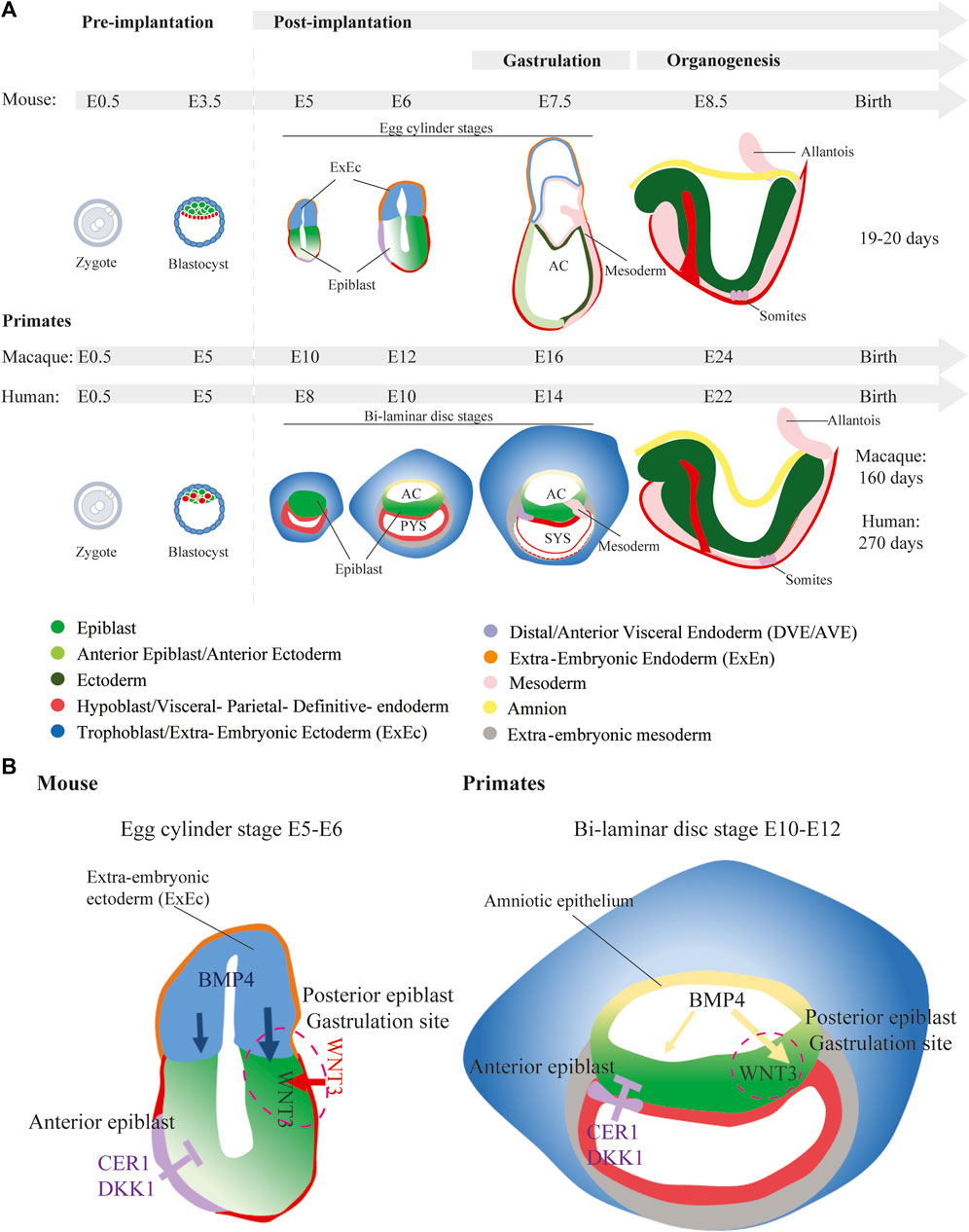Life Unfoldingを読んでいたら、初期発生の話でマウスでの知見が紹介されていました。その中で、anterior visceral endoderm (AVE)という言葉が出てきて、知らなかったので論文などをメモっておきます。
マウスの内胚葉形成
カエルの発生の場合、内胚葉といえばもともとの卵の内側の部分に由来するものでした。しかしマウスの発生においては事情がかなり異なります。将来外肺葉になるepiblast細胞が細胞移動した結果内胚葉や中胚葉ができるのです。また、哺乳類の胚は、胎盤が形成されるため、胚内中胚葉と胚外中胚葉といった具合に、胚内(胚そのものの部分のこと)と胚外(羊膜、絨毛膜、胎盤など)との区別が大事になります。
人とマウスとの違いも大事です。マウスでは初期の胚の形が「カップ状」(egg cylinderと呼ばれる)ですが、人間の場合は平たんな2層の円盤(bilaminar diskと呼ばれる)です。
- The terminology of “endoderm” is confusing for the mouse, where first, the layer of extraembryonic tissues covering the epiblast is also termed endoderm, and second, the endoderm is initially the outermost germ layer of the embryo due to an “inside-out” arrangement of germ layers. 内胚葉という呼称が混乱を招きやすい理由2つ
- The extraembryonic “endoderm” surrounding the early epiblast is the visceral endoderm and it is derived from the inner cell mass of the blastocyst
- The epiblast of the mouse embryo contains the precursors of the definitive endoderm 内胚葉の細胞の起源は、エピブラスト細胞
- The epiblast of the mouse embryo is a cup-shaped epithelial layer covered on its basal surface by the visceral endoderm. カップ状の形状
- After egression from the primitive streak, definitive endoderm cells are incorporated into the pre-existing epithelium, the visceral endoderm. 内胚葉細胞は置き換えが起きる
マウス初期胞胚がエッグシリンダーの形状をとることについて:人間との違い
Mice go through egg cylinder stages of development, whereas primates form a bi-laminar disc.
https://www.frontiersin.org/articles/10.3389/fcell.2024.1386739/full
New paper by the Zernicka-Goetz group shows that cross-talk between the embryonic epiblast and the extraembryonic trophectoderm orchestrates the transformation of the blastocyst to the egg cylinder
https://www.pdn.cam.ac.uk/news/morphogenesis-of-extra-embryonic-tissues-directs-the-remodelling-of-the-mouse-embryo-at-implantation
- Modeling Mammalian Commitment to the Neural Lineage Using Embryos and Embryonic Stem Cells REVIEW article Front. Physiol., 11 July 2019 Sec. Developmental Physiology Volume 10 – 2019 | Each blastomere is totipotent and expresses genetic markers of the future pluripotent inner cell mass (ICM) (e.g., Oct4, Nanog and Rex1) as well as extraembryonic lineages (e.g., Gata6 and Sox17) (Figure 1; Medvedev et al., 2008; Toyooka et al., 2008; Kellner and Kikyo, 2010; Niakan et al., 2010; Wamaitha et al., 2015). At 5.5 dpc the embryo is known as the egg cylinder.
前方臓側内胚葉 anterior visceral endoderm (AVE)とは
A–P polarity is established in the mouse embryo when the distal visceral endoderm (DVE) migrates toward the future anterior side at embryonic day (E) 5.5 (refs. 2,3,4,5,6,7). Concomitant with DVE migration, all visceral endoderm (VE) cells in the embryonic region undergo global movement, resulting in the localization of some VE cells at the distal tip of the embryo. These VE cells at the distal tip will become the anterior visceral endoderm (AVE) and migrate toward the future anterior side of the embryo by following the migration of DVE8.
Both Nodal signalling and stochasticity select for prospective distal visceral endoderm in mouse embryos Nature Communications Published: 14 November 2017 https://www.nature.com/articles/s41467-017-01625-x
Nodal signaling from the visceral endoderm is required to maintain Nodal gene expression in the epiblast and drive AVE migration Dev Biol. 2015 Apr 1; 400(1): 1–9. doi: 10.1016/j.ydbio.2014.12.016 https://www.ncbi.nlm.nih.gov/pmc/articles/PMC4806383/
- Role of the anterior visceral endoderm in restricting posterior signals in t he mouse embryo February 2001The International Journal of Developmental Biology 45(1):311-20 February 200145(1):311-20 https://www.researchgate.net/publication/12041905_Role_of_the_anterior_visceral_endoderm_in_restricting_posterior_signals_in_the_mouse_embryo
遠位臓側内胚葉 distal visceral endoderm (DVE)とは
- マウス胚前後方向を決定する遠位臓側内胚葉の標識遺伝子Hex遺伝子
- 別の遠位臓側内胚葉の標識遺伝子であるLefty1遺伝子
- 遠位臓側内胚葉は受精後4.0日胚においてすでに運命決定している
- 遠位臓側内胚葉と前方臓側内胚葉とは異なる細胞系譜
- 遺伝的な除去実験 遠位臓側内胚葉は前後方向を決定する役割 頭部を誘導する前方臓側内胚葉を前側へとガイド
https://first.lifesciencedb.jp/archives/2913
- Nodal (a secreted member of the TGF-β superfamily) is required for DVE formation
- Bone morphogenetic proteins (BMPs) (secreted ligands of the TGF-β superfamily ): potential regulators of A-P patterning.
- In the mouse embryo, anterior identity is established in the extraembryonic endoderm before formation of the primitive streak
- BMP signaling might regulate formation of the A-P axis, DVE in particular.
https://rupress.org/jcb/article/184/2/323/54037/Antagonism-between-Smad1-and-Smad2-signaling
分子シグナル
https://www.sciencedirect.com/science/article/pii/S0012160604005871


